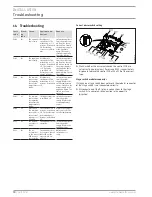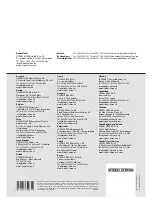
EN
GL
ISH
www.stiebel-eltron.com
LWZ 70 E |
11
INSTALLATION
Installation
26
�0
4�
15
�0
07
9
f
f
Place the rubber strips supplied on the rail mounted on the
wall. The rubber strip helps provide sound insulation.
f
f
Fit the appliance so that the two rails interlock.
10.2 Connecting the condensate drain
!
Material losses
Never kink the hose, to ensure the condensate drains
perfectly. The fall must be at least 10 %. Ensure the device
is level after installation.
> 60
D
00000
41
96
0
The condensate drain is routed through the floor plate. The con-
densate must drain away via the domestic sewer system.
f
f
Secure the condensate drain connector supplied along with
the gasket and union nut to the condensate drain located un-
derneath the appliance.
You can fit the condensate drain pipe (bent if required) to this
condensate drain connector with a glued joint.
f
f
Before connecting the condensate drain to the appliance,
pour water into the siphon to create a stench trap.
The condensate drain pipe must terminate below the water level
in the siphon. The condensate drain pipe must be immersed in
the water in the siphon by at least 60 mm.
10.3 Connecting air ducts
During installation, ensure that no metal swarf enters the
ductwork. However, should this still occur, you must remove this
material, otherwise the fans may be damaged.
External wall ducts
Supply outdoor air from a location where contamination (dust,
soot, odours, flue gas, exhaust air) is as low as possible.
When installing external wall ducts, prevent any short circuit be-
tween the air intake and the air discharge.
Silencers
Install a silencer in both the supply air and extract air ducts. We
recommend installing additional silencers if required to avoid
sound transmission.
If a room with a high noise level must be ventilated, install addi-
tional silencers upstream of this room to reduce sound transmis-
sion to adjacent rooms.
Aspects such as carried voices and impact sound must also be
taken into consideration in the case of ducts embedded in con-
crete. Carried voices should be avoided by designing the duct
with separate branches to the extract air and supply air valves.
If required, insulate the supply air ducts, e.g. if they are outside
the insulated wall panel.
Overflow apertures
In living rooms and bedrooms, air is only blown in. Air is only
extracted from rooms where odours and moisture are generated.
Ventilation grilles must be installed in internal doors or walls,
or the air gap beneath the door must be increased to ≥ 8 mm to
ensure an unobstructed air flow.
Insulation against condensation
!
Material losses
When warm air meets cold surfaces, condensation can
result.
f
f
For outdoor air and exhaust air ducts, use va-
pour-proof thermally insulated pipes.
f
f
If you use uninsulated pipes and moulded parts for
this pipework, ensure that they are adequately insu-
lated.
f
f
Insulate the supply air and extract air ducts if they
are routed through unheated rooms.
The extract air duct does not require a control valve, because the
necessary air flow rates are controlled by the appliance itself.










































